As we head into winter, I’m seeing more Chevy Bolt EV owners call out extreme fluctuations in their projected range. Many of those owners tend to drive slowly – at city speeds, and their projected ranges often exceed 300 miles on a vehicle that is only rated for 238 miles of combined range under EPA testing. With winter setting in and heater usage increasing, many of those same Bolt EV owners are now seeing projected ranges of less than 200 miles.
This has led to claims that the Range Estimator that GM designed for the Chevy Bolt EV is highly inaccurate, and some have even started to refer to it as a “Guess-o-meter,” the same derisive term used to describe the range estimator in the Nissan Leaf, which was notorious for displaying inaccurate range estimates.
In this story, I will describe the difference between the Chevy Bolt EV’s projected range and its Range Estimator, and I will explain how to use each element of the Bolt EV’s Range Estimator. To illustrate, I will share some images of my Range Estimator during a recent trip to point out how it varies over time with various types of driving.
What Is the Chevy Bolt EV Range Estimator?
Currently, most other electric vehicle automakers only include the EV’s estimated range and available capacity on the Driver Information Center (DIC) display; however, GM chose to build a more complex tool to display additional information that updates in real-time. In my opinion, the Bolt EV's Range Estimator is one of the most accurate range projection tools available in any EV today.
So why do so many drivers seem to have issues with the Range Estimator’s accuracy? From what I can see, it is because those drivers are focusing only on the projected range numbers rather than the Range Estimator as a whole.
While the Bolt EV’s Range Estimator, does include an average projected range, just like every other EV, it also provides maximum and average projected ranges that based on recent driving history, current conditions, and climate control settings. Also like most other EVs, the Bolt EV’s Range Estimator displays the battery's state of charge (percent full), which is shown in 5% increments.
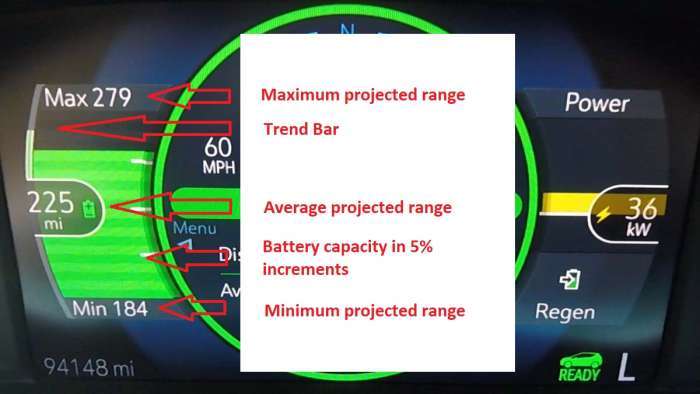
The Range Estimator feature most people seem to overlook is the Trend Bars, which is unfortunate because they are in my opinion one of the most useful aspects of the Bolt EV’s range estimator. The Trend Bars account for current energy consumption from driving and onboard systems, and indicate whether you are trending toward your minimum or maximum projected range. If the Trend Bars are not present, the Range Estimator is telling you that your current driving best aligns with the average projected range.
As you drive, the Range Estimator is constantly seeking equilibrium with the trend bars, which is why the maximum and average projected ranges tend to fluctuate over the course of a long drive. The minimum projected range is very pessimistic, and it tends to fluctuate much less (and to a much lesser degree) than the average and maximum projected ranges.
Limitations of the Bolt EV's Range Estimator
Yes, the Chevy Bolt EV’s Range Estimator is a powerful tool while taking trips, but it still is limited. The Range Estimator can only calculate based on recent driving history and current conditions. Any factors that deviate from the information it currently has access to will affect the accuracy of your projected range.
One of the biggest limitations people must understand about the Bolt EV’s Range Estimator is that it is not a route planner. It doesn’t sync with Google Maps or a navigation system, so it can’t account for the driving speeds, topography, or weather that you might encounter in the future. Ultimately, as the driver, you are responsible for knowing where you are going and how you plan to drive there.
Another key limitation of the Range Estimator is that it doesn’t provide the battery level in 1% increments. For electric vehicles with 200 or more miles of range, the 5% increments start to become an issue. Each green bar can represent 10 miles or more of driving range, which means that by the time it ticks down to the next green bar, you might have used far more energy than you realized to travel just a few miles.
Finally, the Range Estimator isn’t a promise. This works both positively and negatively. If you get into a Bolt EV on a sunny, 70 degree day and see 150 miles of projected range on a full battery, you’re more than likely going to exceed that. However, on the side of the coin, if you’ve been driving around town all week and see a projected range of 300 miles, don’t expect to get that much range out of a single battery charge driving at 75 mph.
Chevy Bolt EV's Range Estimator in Practice
I decided to capture some images of my Range Estimator on a recent trip so that I could share them and use them to explain both the Range Estimator and how I use it while driving. For this leg of the trip, I was only starting with about 75% battery, and I was driving from Ventura to Bakersfield, California. This 115-mile drive is almost exclusively on the freeway, and it requires driving over a 4,000’ mountain range.
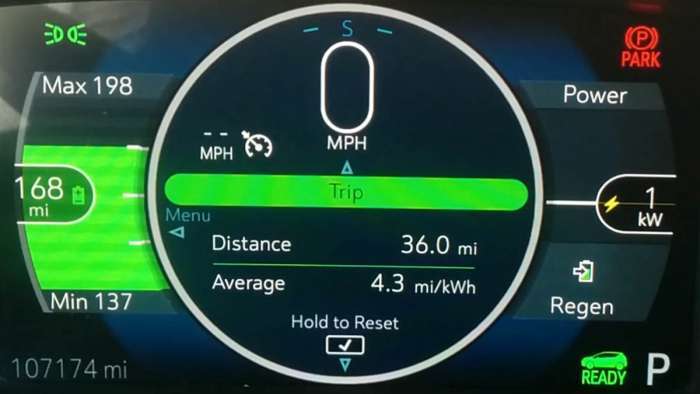
You’ll note that I called out my battery percentage when leaving. The battery percentage is possibly the most important information the Range Estimator provides, and some of the more experienced Bolt EV drivers I know say that it is the only aspect of the Range Estimator they pay attention to on trips. Essentially, as long you know the capacity of the battery and your expected efficiency, you can calculate the available range yourself simply by seeing how much energy is left in the battery.
In many ways, this strategy is similar to how people drive internal combustion vehicles that only have a gas gauge and no projected range display. That is actually the strategy I used for this trip as my recent driving resulted in far better efficiency than I anticipated on this trip, and the Trend Bars are not available until after driving for a while.
Range Estimator on Departing Ventura
As I was getting ready to leave, I took a snapshot of my DIC. My recent driving resulted in 4.3 mi/kWh efficiency, which is more representative of local driving than the long freeway drive I was about to do. The Range Estimator showed that I had as much as 75% battery, but I rounded down and assumed that I only had 70% of my now 55 kWh battery capacity available (see my recent story on my Chevy Bolt EV’s battery degradation).
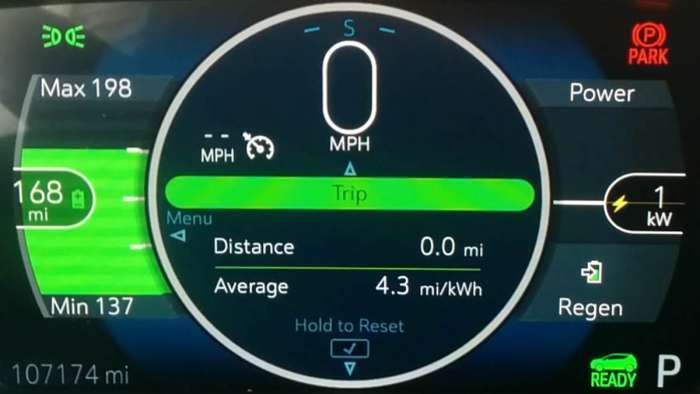
I mostly ignore the projected ranges other than the Min range, which tends to be fairly close. The Max projected range of 198 miles would only be achievable if I continued to drive locally a low speeds, and the average projected range of 168 miles was equally optimistic. My Min projected range of 137 miles was far more believable (my rule of thumb is 50 miles for every 25% battery at typical freeway speeds), but as I found out later, I was also facing a headwind.
I reset the Trip Meter to 0 miles and headed out.
Range Estimator At Tejon Pass
The next snapshot I took of the Range Estimator is from when I was approaching Tejon Pass, which is 4,144 feet above sea level (I had started on the coast just above sea level). Typically, my Bolt EV’s efficiency is somewhere between 2.8 and 3.1 mi/kWh by the time I reach Tejon Pass; however, in this case, I had to slog through a 20 mph headwind coming up Highway 126.
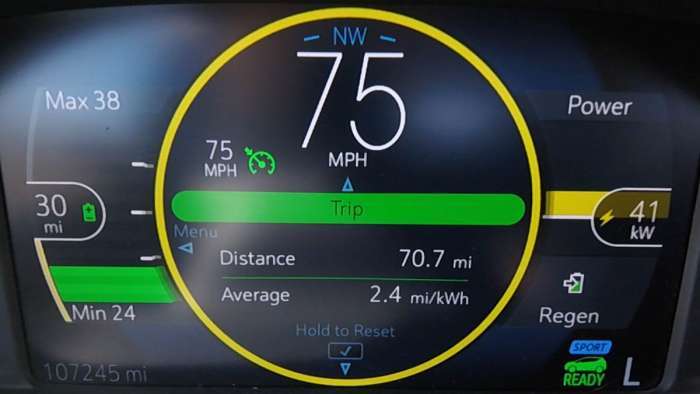
But this is the point where I want to call out how ineffective the project range estimates can be. I had nearly 45 miles left to drive, but according to my projected ranges, I had a Max of 38 miles, a Min of 24 miles, and an average of 30 miles of projected range. I knew that the next 45 miles of driving would be downhill, so I would not only be driving for free but also recouping some energy. However, the Range Estimator had no way of anticipating that. In fact, the Trend Bar on the Range Estimator was telling me that if I kept driving at my current pace under these conditions, I was most likely to see the Min projected range of 24 miles.
Range Estimator at Base of the Grapevine
By the time I reached the base of the Grapevine (the downhill from the Tejon Pass), I had recouped enough energy and regained enough efficiency that my projected ranges now showed that I would be able to complete the trip to Bakersfield. I had less than 30 miles left to drive, and even the Min projected range of 28 miles indicated that I would make it. But more importantly, the Trend Bar had now switched to green and was near the Max projected range of 44 miles, indicating that I could expect that range if current driving trends continued.
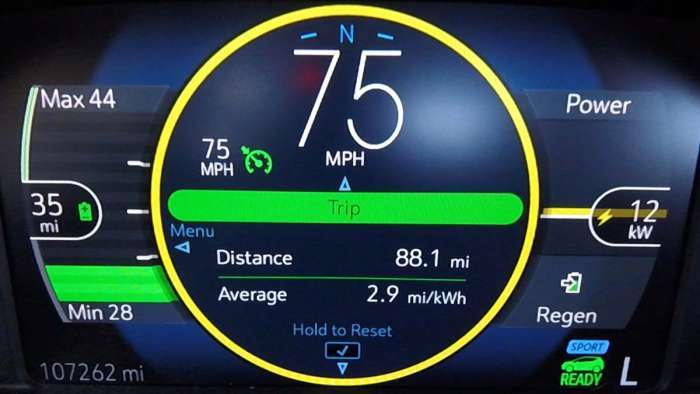
Unfortunately, that was about the end of the significant downhill run, so while my driving would still continue to improve in terms of efficiency, I would no longer be able to drive for free or recoup energy as I did on the significant downhill grade following Tejon Pass.
Range Estimator Pulling Into Electrify America Bakersfield
By the time I arrived in Bakersfield 45 miles later, I had used most of my remaining battery. My trip efficiency was now up to 3.1 mi/kWh; however the Range Estimator was no longer providing any information other than that the battery was “Low.”
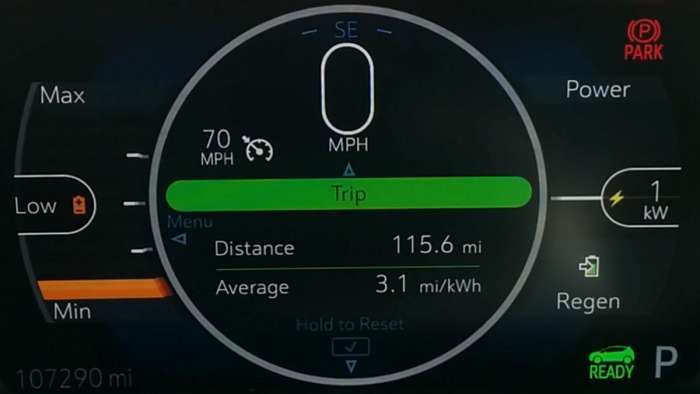
When the battery level hits 15%, the Range Indicator will change color to orange, but it will provide no other feedback. When the battery level hits 10%, it will provide an audible signal and post a message on the DIC to charge the vehicle soon. When the battery level hits 5%, the Range Estimator no longer provides projected ranges. It simply indicates that the battery is low. It will also turn off the option for Sport mode and reduce propulsion power (peak power still appears to be about 100 kW).
Conclusion
As you can see from my trip example, while the Range Estimator is very good at calculating range based on available information, it falls short when it comes to anticipating changes in driving characteristics, terrain, or weather. So ultimately, those are the responsibility of the driver to account for, but if you are unsure, it’s best to use outside trip and route planners that account for those factors.
See you in the next story where I am discussing how Chevrolet electrifies with its E-10 conversion concept at SEMA.
About The Author
Eric Way focuses on reporting expert opinion on GM brand electric vehicles at Torque News. Eric is also an instructional designer and technical writer with more than 15 years of writing experience. He also hosts the News Coulomb video blog, which focuses on electric vehicles, charging infrastructure, and renewable energy. Eric is an active member of the EV Advocates of Ventura County, a volunteer organization focused on increasing the widespread adoption of electric vehicles. You can follow Eric on News Coulomb Youtube, on Facebook at @NewsCoulomb as well as on Twitter at @eway1978.

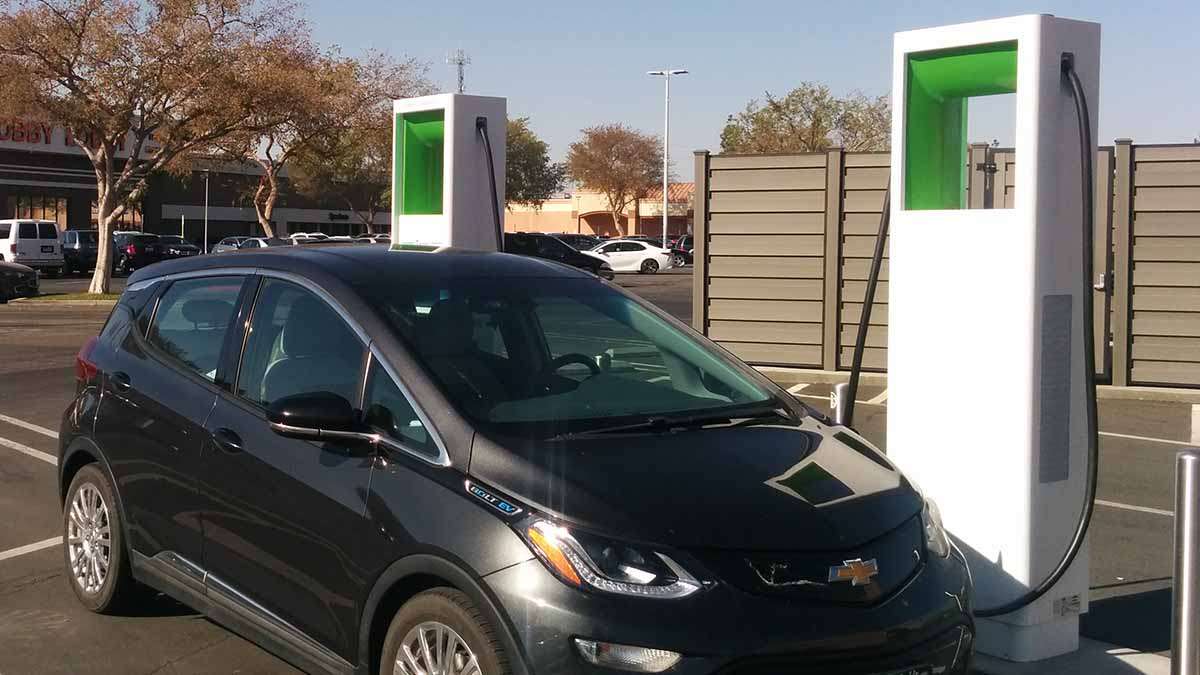




Comments
I'm a brand new Bolt owner
Permalink
I'm a brand new Bolt owner and this is the exact information I was looking for to understand my Bolt better. I have found no such info anywhere else. Thank you for describing it so completely.
I have a new 2021 Bolt and
Permalink
I have a new 2021 Bolt and your article was SO informative and contained information that was not known at the dealership or in the car manuals. I really appreciate your expertise.
Thank you, Andy Kosseff
Eric,
Permalink
Eric,
I have been a follower of your YouTube channel since I got my Bolt in 2017 and have taken the time to determine the Bolt's base efficiency as a function of speed (on level ground with no wind) by making several speed runs in the Imperial valley. The data can be fit by a linear equation: Efficiency(mi/kWh)=8.42-0.0743S where is is the speed in mph. The data cover the range from 35mph to 75mph. I have augmented this equation for trips to account for elevation difference between the beginning and end of a trip leg, and included corrections for head/tail wind. I have used this equation for two round trips from San Diego to Colorado and it works very well. I made a pdf document that describes all this and have sent to Steve of 'Plug and Play' and would be happy to send it to you for your comments, if interested.
Rob
Thank you for the very
Permalink
Thank you for the very informative article. I just had my batteries replaced, under recall, on my 2017 Bolt. I was expecting to see a large increase in range but it did not occur. I understand why. It is winter here in Canada now and I am using my environmental controls much more and my range in general has drifted down. Your article confirmed my suspicion on what was happening thank again for the excellent article
Does anyone know how "recent
Permalink
Does anyone know how "recent driving history" is defined for the Bolt? Is the it related to the tripmeter or is it some fixed number of days?